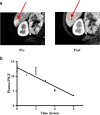Reverse translation of phase I biomarker findings links the activity of angiotensin-(1-7) to repression of hypoxia inducible factor-1α in vascular sarcomas
- PMID: 22963500
- PMCID: PMC3495013
- DOI: 10.1186/1471-2407-12-404
Reverse translation of phase I biomarker findings links the activity of angiotensin-(1-7) to repression of hypoxia inducible factor-1α in vascular sarcomas
Abstract
Background: In a phase I study of angiotensin-(1-7) [Ang-(1-7)], clinical benefit was associated with reduction in plasma placental growth factor (PlGF) concentrations. The current study examines Ang-(1-7) induced changes in biomarkers according to cancer type and investigates mechanisms of action engaged in vitro.
Methods: Plasma biomarkers were measured prior to Ang-(1-7) administration as well as 1, 2, 3, 4, and 6 hours after treatment. Tests for interaction were performed to determine the impact of cancer type on angiogenic hormone levels. If a positive interaction was detected, treatment-induced biomarker changes for individual cancer types were assessed. To investigate mechanisms of action, in vitro growth assays were performed using a murine endothelioma cell line (EOMA). PCR arrays were performed to identify and statistically validate genes that were altered by Ang-(1-7) treatment in these cells.
Results: Tests for interaction controlled for dose cohort and clinical response indicated a significant impact of cancer type on post-treatment VEGF and PlGF levels. Following treatment, PlGF levels decreased over time in patients with sarcoma (P = .007). Treatment of EOMA cells with increasing doses of Ang-(1-7) led to significant growth suppression at doses as low as 100 nM. PCR arrays identified 18 genes that appeared to have altered expression after Ang-(1-7) treatment. Replicate analyses confirmed significant changes in 8 genes including reduction in PlGF (P = .04) and hypoxia inducible factor 1α (HIF-1α) expression (P < .001).
Conclusions: Ang-(1-7) has clinical and pre-clinical activity for vascular sarcomas that is linked to reduced HIF-1α and PlGF expression.
Figures




Similar articles
-
Erythropoietin-mediated expression of placenta growth factor is regulated via activation of hypoxia-inducible factor-1α and post-transcriptionally by miR-214 in sickle cell disease.Biochem J. 2015 Jun 15;468(3):409-23. doi: 10.1042/BJ20141138. Epub 2015 Apr 16. Biochem J. 2015. PMID: 25876995 Free PMC article.
-
Epigenetic control of hypoxia inducible factor-1α-dependent expression of placental growth factor in hypoxic conditions.Epigenetics. 2014 Apr;9(4):600-10. doi: 10.4161/epi.27835. Epub 2014 Feb 6. Epigenetics. 2014. PMID: 24504136 Free PMC article.
-
Expression of placenta growth factor, soluble fms-like tyrosine kinase-1, metal-responsive transcription factor-1, heme oxygenase 1 and hypoxia inducible factor-1α mRNAs in pre-eclampsia placenta and the effect of pre-eclampsia sera on their expression of choriocarcinoma cells.J Obstet Gynaecol Res. 2014 Oct;40(10):2095-103. doi: 10.1111/jog.12462. Epub 2014 Aug 11. J Obstet Gynaecol Res. 2014. PMID: 25132343
-
Hypoxia-inducible factor-1 mediates activation of cultured vascular endothelial cells by inducing multiple angiogenic factors.Circ Res. 2003 Oct 3;93(7):664-73. doi: 10.1161/01.RES.0000093984.48643.D7. Epub 2003 Sep 4. Circ Res. 2003. PMID: 12958144
-
Angiotensin-(1-7) reduces proliferation and angiogenesis of human prostate cancer xenografts with a decrease in angiogenic factors and an increase in sFlt-1.Prostate. 2013 Jan;73(1):60-70. doi: 10.1002/pros.22540. Epub 2012 May 29. Prostate. 2013. PMID: 22644934
Cited by
-
HIF-hypoxia signaling in skeletal muscle physiology and fibrosis.J Cell Commun Signal. 2020 Jun;14(2):147-158. doi: 10.1007/s12079-020-00553-8. Epub 2020 Feb 22. J Cell Commun Signal. 2020. PMID: 32088838 Free PMC article. Review.
-
The potential role of renin angiotensin system in acute leukemia: a narrative review.Mol Biol Rep. 2024 Jun 21;51(1):775. doi: 10.1007/s11033-024-09659-3. Mol Biol Rep. 2024. PMID: 38904729 Review.
-
Exogenous Ang-(1-7) inhibits autophagy via HIF-1α/THBS1/BECN1 axis to alleviate chronic intermittent hypoxia-enhanced airway remodelling of asthma.Cell Death Discov. 2023 Oct 2;9(1):366. doi: 10.1038/s41420-023-01662-0. Cell Death Discov. 2023. PMID: 37783703 Free PMC article.
-
Stabilization of Angiotensin-(1-7) by key substitution with a cyclic non-natural amino acid.Amino Acids. 2017 Oct;49(10):1733-1742. doi: 10.1007/s00726-017-2471-9. Epub 2017 Jul 25. Amino Acids. 2017. PMID: 28744580 Free PMC article.
-
Phase II Trial of Angiotensin-(1-7) for the Treatment of Patients with Metastatic Sarcoma.Sarcoma. 2016;2016:4592768. doi: 10.1155/2016/4592768. Epub 2016 Nov 8. Sarcoma. 2016. PMID: 27895527 Free PMC article.
References
-
- Machado RD, Santos RA, Andrade SP. Opposing actions of angiotensins on angiogenesis. Life Sci. 2000;66:67–76. - PubMed
Publication types
MeSH terms
Substances
Grants and funding
LinkOut - more resources
Full Text Sources
Other Literature Sources
Medical
Miscellaneous

